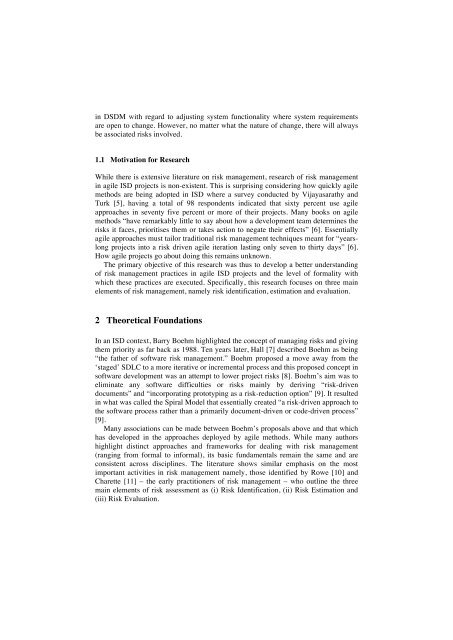Risk Management in Agile Methods: A Study of DSDM in ... - ARAN
Risk Management in Agile Methods: A Study of DSDM in ... - ARAN
Risk Management in Agile Methods: A Study of DSDM in ... - ARAN
You also want an ePaper? Increase the reach of your titles
YUMPU automatically turns print PDFs into web optimized ePapers that Google loves.
<strong>in</strong> <strong>DSDM</strong> with regard to adjust<strong>in</strong>g system functionality where system requirements<br />
are open to change. However, no matter what the nature <strong>of</strong> change, there will always<br />
be associated risks <strong>in</strong>volved.<br />
1.1 Motivation for Research<br />
While there is extensive literature on risk management, research <strong>of</strong> risk management<br />
<strong>in</strong> agile ISD projects is non-existent. This is surpris<strong>in</strong>g consider<strong>in</strong>g how quickly agile<br />
methods are be<strong>in</strong>g adopted <strong>in</strong> ISD where a survey conducted by Vijayasarathy and<br />
Turk [5], hav<strong>in</strong>g a total <strong>of</strong> 98 respondents <strong>in</strong>dicated that sixty percent use agile<br />
approaches <strong>in</strong> seventy five percent or more <strong>of</strong> their projects. Many books on agile<br />
methods “have remarkably little to say about how a development team determ<strong>in</strong>es the<br />
risks it faces, prioritises them or takes action to negate their effects” [6]. Essentially<br />
agile approaches must tailor traditional risk management techniques meant for “yearslong<br />
projects <strong>in</strong>to a risk driven agile iteration last<strong>in</strong>g only seven to thirty days” [6].<br />
How agile projects go about do<strong>in</strong>g this rema<strong>in</strong>s unknown.<br />
The primary objective <strong>of</strong> this research was thus to develop a better understand<strong>in</strong>g<br />
<strong>of</strong> risk management practices <strong>in</strong> agile ISD projects and the level <strong>of</strong> formality with<br />
which these practices are executed. Specifically, this research focuses on three ma<strong>in</strong><br />
elements <strong>of</strong> risk management, namely risk identification, estimation and evaluation.<br />
2 Theoretical Foundations<br />
In an ISD context, Barry Boehm highlighted the concept <strong>of</strong> manag<strong>in</strong>g risks and giv<strong>in</strong>g<br />
them priority as far back as 1988. Ten years later, Hall [7] described Boehm as be<strong>in</strong>g<br />
“the father <strong>of</strong> s<strong>of</strong>tware risk management.” Boehm proposed a move away from the<br />
‘staged’ SDLC to a more iterative or <strong>in</strong>cremental process and this proposed concept <strong>in</strong><br />
s<strong>of</strong>tware development was an attempt to lower project risks [8]. Boehm’s aim was to<br />
elim<strong>in</strong>ate any s<strong>of</strong>tware difficulties or risks ma<strong>in</strong>ly by deriv<strong>in</strong>g “risk-driven<br />
documents” and “<strong>in</strong>corporat<strong>in</strong>g prototyp<strong>in</strong>g as a risk-reduction option” [9]. It resulted<br />
<strong>in</strong> what was called the Spiral Model that essentially created “a risk-driven approach to<br />
the s<strong>of</strong>tware process rather than a primarily document-driven or code-driven process”<br />
[9].<br />
Many associations can be made between Boehm’s proposals above and that which<br />
has developed <strong>in</strong> the approaches deployed by agile methods. While many authors<br />
highlight dist<strong>in</strong>ct approaches and frameworks for deal<strong>in</strong>g with risk management<br />
(rang<strong>in</strong>g from formal to <strong>in</strong>formal), its basic fundamentals rema<strong>in</strong> the same and are<br />
consistent across discipl<strong>in</strong>es. The literature shows similar emphasis on the most<br />
important activities <strong>in</strong> risk management namely, those identified by Rowe [10] and<br />
Charette [11] – the early practitioners <strong>of</strong> risk management – who outl<strong>in</strong>e the three<br />
ma<strong>in</strong> elements <strong>of</strong> risk assessment as (i) <strong>Risk</strong> Identification, (ii) <strong>Risk</strong> Estimation and<br />
(iii) <strong>Risk</strong> Evaluation.
















